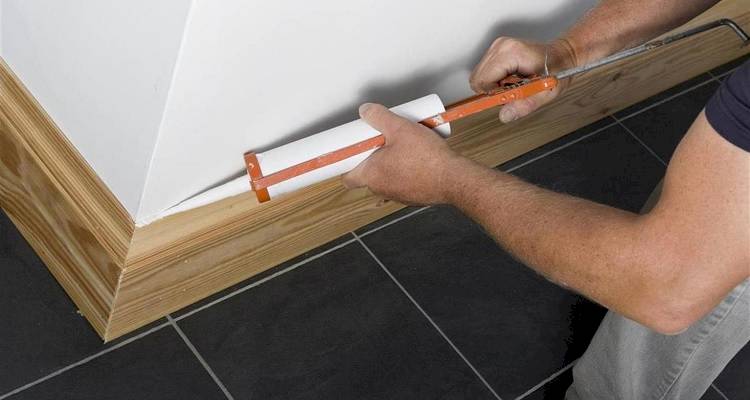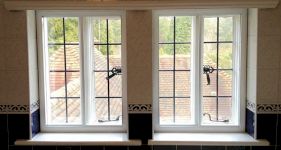Suspended Ceiling Installation Cost
- The average cost of installing a false ceiling is £33 per m².
- It usually takes 6 to 8 hours to fit false ceilings.
- A complete false ceiling installation cost breakdown, including the cost per m² for different types of suspended ceilings.
- How long false ceiling installation takes, and a range of jobs you might like to do at the same time.
- How to find and hire a local suspended ceiling installer.
Thinking about installing a suspended or false ceiling in your home or business?
False ceilings are popular for hiding pipework or wiring, improving insulation, and giving rooms a modern, polished look. In this guide, we’ll break down the costs for different ceiling types, from budget-friendly tiles to high-end plasterboard systems, plus what affects the final price.
Ready to get a quote for your project?
More than 1 million homeowners across the UK use MyJobQuote every year to find trusted tradespeople near them. Simply tell us a few details about your ceiling project, and we’ll connect you with local installers for free, no-obligation quotes.
Want to learn more before you get started? Keep reading to find out what to expect when installing a false ceiling.
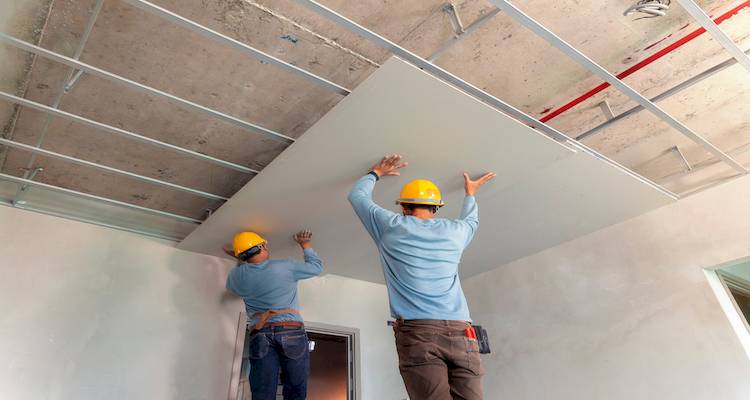
£33 per m²
Table of Contents
- How Much Does a Suspended Ceiling Installation Cost?
- Suspended & False Ceiling Costs by Room Type
- Suspended Ceiling Supply Costs
- Additional False Ceiling Costs & Considerations
- Suspended Ceiling Labour Cost & Timescales
- Factors That Impact False Ceiling Costs
- What's Involved in Installing a False Ceiling?
- Can I Install a False or Suspended Ceiling Myself?
- Building Regulations & Planning Permission for Installing A Suspended Ceiling
- Types of False Ceiling
- Checklist: Hiring Contractors for Installing A False/Suspended Ceiling
- FAQs
How Much Does a Suspended Ceiling Installation Cost?
In this article, we will go over everything you need to know about the costs involved with this type of work, including the supply costs, labour costs, and any additional costs that may come up.
We will also provide you with some additional information about false/suspended ceilings, such as the installation method, the cost factors of this work, the building regulations and planning permission rules, the different types of false or suspended ceilings, and some tips on hiring the right contractors for the job.
Suspended ceilings are most commonly used in industrial and commercial settings. However, they are becoming more and more common in residential spaces. They provide a very fast and easy way to cover up old and unattractive ceilings. They are versatile and can look very attractive when fitted right.
These types of ceilings are a great choice when you want to hide any unsightly pipes and wiring. Some varieties also come with fire-resistant properties. These ceilings can also help to improve the acoustics in your home and can provide insulation.
It's very unlikely that two suspended ceiling jobs will be the same, so it can be difficult to determine the price for this job. However, the average cost for a suspended ceiling is around £22 to £35 per m².
The price will vary depending on the size of your ceiling, the location of your property, and the materials used. If you are based in the London area, you can expect to pay more for this work than if you were based in the North or other parts of the UK.
False Ceiling Prices
Below is a table showing the average cost of a suspended ceiling:
| JOB DESCRIPTION | FALSE/SUSPENDED CEILING PRICES |
|---|---|
| Low-end suspended ceiling cost | £16 - £20 per m² |
| Mid-range suspended ceiling cost | £22 - £35 per m² |
| High-end suspended ceiling cost | £40 - £60 per m² |
| Insulation cost | £5 - £8 per m² |
Suspended & False Ceiling Costs by Room Type
The total price of a false of suspended ceiling will vary depending on the room size, layout, and finish you want. To give you a clearer idea of what to expect, here are some example scenarios showing typical installation costs for different types of rooms. These estimates include both labour and materials.
| Room / Project Type | Avg. Room Size (m²) | Typical System & Materials | Est. Total Cost (Supply & Fit) |
|---|---|---|---|
| Home Office | 10m² | Mid-Range Acoustic Grid | £250 - £450 |
| Kitchen | 15m² | Mid-Range Vinyl (Wipeable) Grid | £450 - £750 |
| Garage Conversion | 18m² | Budget Fire/Insulation Grid | £400 - £650 |
| Living Room | 20m² | High-End MF Plasterboard | £1,000 - £1,500 (incl. skimming) |
| Home Cinema | 20m² | High-End Acoustic MF System | £1,400 - £2,400+ |
These examples are based on average UK installation rates of around £22 – £35 per m² for a typical suspended ceiling. The final cost will depend on how straightforward the room layout is, the ceiling height, and whether additional work is required for lighting, insulation, or soundproofing.
Suspended Ceiling Supply Costs
In some cases, you may be interested in learning more about the supply costs for this type of work. This may be the case if you are planning on installing the ceiling yourself or if you are planning on buying the materials upfront and then sourcing the contractors at a later date.
Suspended ceiling tiles cost varying amounts depending on the size, style, type, and material.
You can expect to pay around £4 to £10 per m² on average for suspended ceiling tiles. The price for the tiles will vary depending on the style and quality of the materials that they are made with.
Additional False Ceiling Costs & Considerations
Your main quote will cover the basic ceiling installation. However, several common "add-ons" or related jobs can affect the total price. Here's what to budget for:
Removal of Old Ceiling
If you are replacing an existing suspended or lath-and-plaster ceiling, this must be removed and disposed of first. This is a labour-intensive, messy job. Expect to add £150 to £400 to your total cost, depending on the room size and ceiling type.
If your home (or the ceiling you are removing) dates from before 2000, it may contain asbestos. You must have it tested. An asbestos survey costs around £50 to £100 for a single test.
Ceiling Insulation
This is the most common add-on. Adding a layer of thermal or acoustic insulation (like Rockwool) on top of the new ceiling is highly effective. Budget for an additional £5 to £8 per m².
New Light Fittings
Your installer can fit new lights, but the cost is often broken down into labour and materials.
- Labour: The cost to install new light fittings is typically £80 to £200 for the room.
- Materials: The fittings themselves are an extra cost. Integrated 600x600 LED panels (for grid ceilings) cost £40 to £80 each, while LED spotlights (for plasterboard ceilings) cost £15 to £30 each.

Plastering & Decorating
This is a crucial point that depends on your ceiling type:
- Grid Ceilings: These are pre-finished. No plastering or painting is needed.
- MF Plasterboard Ceilings: The "high-end" MF system requires plastering (skimming) to be finished. This step is usually included in the £40 to £60 per m² price, but you should confirm this with your installer.
If you want the rest of the room updated, you'll need to budget for:
- Plastering the walls: £400 to £1,500 per room.
- Painting the room (walls and new ceiling): £300 to £500.
Skip Hire
Removing an old ceiling, especially a plaster one, creates a lot of heavy waste. The average cost of hiring a skip for this type of work is around £150 to £300.
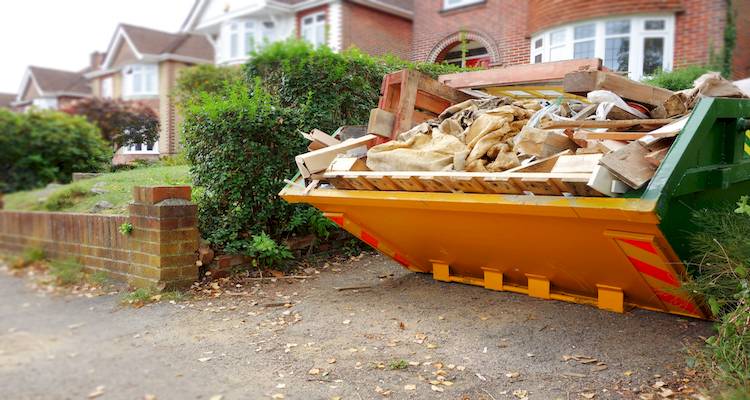
Suspended Ceiling Labour Cost & Timescales
If you are planning on buying the materials for the job separately and then hiring a contractor at a later date, you might then be interested in learning about the price that you might expect to pay for just the labour part of the job alone.
You might also be curious to learn about how long this type of work is expected to take.
You can expect the suspended ceiling specialist to charge around £150 to £200 per day, and a general labourer will charge around £80 to £100 per day.
If the job goes smoothly and no problems arise, your suspended ceiling installation will take no more than a day to complete. If the room is quite large, it may take up to two days.
Factors That Impact False Ceiling Costs
There are several things that can affect the overall cost of installing a suspended ceiling. Below is a list of the things that may affect the cost of this job:
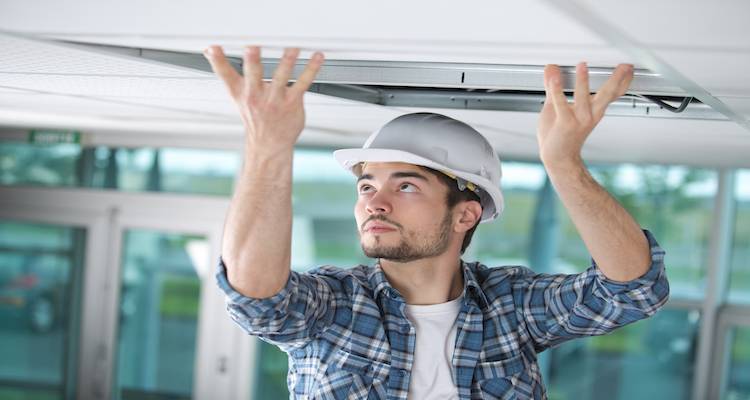
Quality of The Ceiling Tiles
The quality of the ceiling tiles will affect the overall cost of the job. As mentioned earlier, you can choose from low-range, mid-range, or high-range false ceiling panels. The tiles that you choose will determine the overall cost of the job.
Location of Property
The location of your property will also impact the overall cost of installing a suspended ceiling. Those based in and around the London area can expect to pay more for the labour part of the job than those based in the North or different areas of the UK.
This is due to the fact that labour costs in the London area tend to be higher across all industries than in other parts of the UK.
Number of Tradespeople
The number of tradespeople that are working on the job will also affect the job’s cost. More people might be required to work on the ceiling depending on the size and type of suspended ceiling that you choose. The more tradespeople that are needed for the work, the higher the overall price will be due to the additional labour costs.
What's Involved in Installing a False Ceiling?
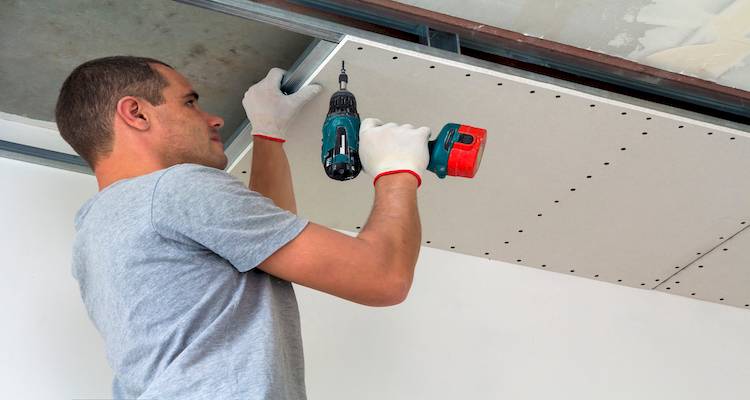
If you’re hiring a professional to install your false or suspended ceiling, it helps to understand what the job involves.
This overview explains each stage of the installation process so you know what to expect before requesting quotes or beginning work.
Depending on room size and complexity, a professional installation typically takes between 1–3 days and costs around £22 to £35 per m² for a standard suspended ceiling, or £40 to £60 per m² for a plasterboard MF system.
Planning & Levelling
The installer will begin by accurately setting out the ceiling height using a laser level. A level line is marked around the room, and fixing points for the main framework are planned to accommodate lights, vents, and any access panels.
Installing Perimeter Trim & Hangers
A perimeter angle (metal wall trim) is fixed along the marked line around the room. The installer then attaches hangers or brackets to the existing joists — these will support the full weight of the new ceiling and keep it perfectly level.
Building the Framework
The main structure is then assembled, but the method used depends on the ceiling type:
- For a Grid Ceiling: A lightweight metal grid is clipped together using “main tees” and “cross tees,” suspended from the ceiling hangers.
- For an MF (Plasterboard) Ceiling: A more rigid Metal Frame (MF) system is built to create a solid surface for plasterboard sheets.
Fitting Panels or Plasterboard
After the framework is complete:
- For a Grid Ceiling: Ceiling tiles (e.g., mineral fibre, metal, or vinyl-faced) are dropped into the grid openings.
- For an MF Ceiling: Large plasterboard sheets are screwed securely to the frame, ready for finishing.
Finishing & Integration
Finally, the installer will cut openings for lighting, air vents, or access hatches. Grid ceilings are generally ready to use straight away, while MF ceilings are jointed, skimmed, and sanded for a smooth, paintable finish. At this stage, decoration and lighting installation are usually completed.
Can I Install a False or Suspended Ceiling Myself?
It’s possible to install a false or suspended ceiling yourself if you have strong DIY skills and experience with Construction projects. However, these systems can be tricky to get right, especially when it comes to achieving a flawless, level finish, supporting the grid securely, and accommodating lighting or insulation.
Any mistakes during installation can lead to uneven panels, gaps, or even safety risks if the frame isn’t properly supported. That’s why most homeowners choose to hire a qualified ceiling installer.
A professional will ensure the grid is correctly aligned, all fixings meet safety standards, and the final finish looks seamless.
If you’re unsure where to start, it’s worth getting a few quotes from local tradesmen. They can assess your room, advise on suitable materials, and provide an accurate total cost before work begins.
Building Regulations & Planning Permission for Installing A Suspended Ceiling
Most suspended or false ceiling projects don’t need planning permission. However, you must still follow relevant Building Regulations to ensure your new ceiling is safe, compliant, and correctly installed. If your property is listed or located in a Conservation area, always check with your local authority before starting work.
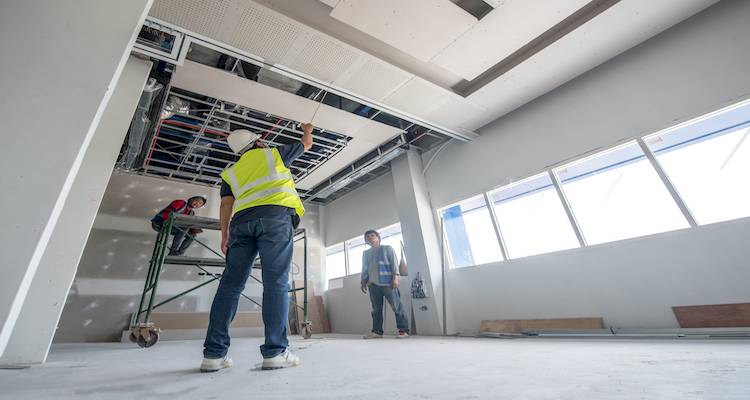
Building Regulations, however, are a different matter and must be followed. While a new ceiling in a typical room may not require an application, the way it is installed and the materials used must comply with specific rules, primarily concerning fire safety and sound.
Key Building Regulations for Ceilings
Here are the main regulations that apply to suspended ceiling installations:
Part B (Fire Safety)
This is the most critical regulation. A new suspended ceiling must not make the room's fire safety worse. In many cases, it must be improved.
- Fire-Rated Ceilings — In commercial buildings, blocks of flats, or between a house and an integrated garage, you will likely be required to install a fire-rated suspended ceiling (e.g., 30-minute or 60-minute rating).
- Void Penetration — Any holes cut for lighting or air-con must be correctly fire-stopped to maintain the ceiling's fire-rating.
Part E (Resistance to Sound)
If you are in an attached property (like a flat or semi-detached house), the ceiling plays a key role in sound insulation. The installation must not breach the existing sound-proofing and should ideally improve it. Using acoustic-rated tiles or insulation is a common way to meet this requirement.
Part F (Ventilation)
The new ceiling void must not interfere with the room's ventilation or airflow. Your installer must ensure that any existing vents or airbricks are properly extended to the new ceiling level.
Room Height
While not a specific "suspended ceiling" rule, general Building Regulations require a minimum ceiling height for a habitable room (typically around 2.3m). Your installer will factor this in.
Always use a qualified installer who understands the regulations in your area. They will be able to advise on the correct fire-rated materials and installation methods to ensure your project is safe and compliant.
Types of False Ceiling
There are several different types of suspended ceiling materials. Below is a list of the various suspended ceiling types and the benefits of each type:
| Ceiling Type | Typical Cost (per m²) | Common Features |
|---|---|---|
| Plasterboard | £40 – £60 | Strong, smooth finish, often skimmed and painted. |
| Mineral Fibre Tiles | £16 – £35 | Excellent sound insulation, cost-effective. |
| Metal Tiles | £60+ | Durable, modern look, ideal for high-end or commercial spaces. |
| Plastic / PVC Panels | £20 – £35 | Low cost, moisture-resistant, lightweight. |
These prices include both materials and installation, based on average UK rates. Your final cost will depend on the ceiling height, grid design, and whether extra features like lighting or insulation are added.
Plasterboard Suspended Ceiling
A plasterboard false ceiling, usually built on a metal frame (MF) system, offers a smooth, seamless finish that can be plastered and painted to match the rest of your décor. While plasterboard tiles themselves are inexpensive, a full MF system (including plastering and finishing) is considered a high-end option due to the materials and labour involved.
On average, expect to pay around £40 to £60 per m² for a professionally installed plasterboard suspended ceiling. It’s ideal for living rooms, bedrooms, and loft conversions where you want a clean, modern look or need to conceal wiring and pipework.
Pros
- ✔ Creates a seamless, modern finish that can be painted
- ✔ Strong and long-lasting
- ✔ Good insulation and fire-resistance properties
Cons
- ✖ More expensive than basic tile systems
- ✖ Requires skilled plastering and longer installation time
Mineral Fibre Suspended Ceiling Tiles
Mineral fibre tiles are one of the most common and affordable options for suspended ceilings. They’re made from natural, synthetic, or recycled materials and are known for excellent sound absorption and insulation properties. These tiles are popular in offices, schools, and home basements.
They're priced at the low-end of the range at roughly £16 to £35 per m², making them a great option for budget builds, where you want a functional ceiling without a premium finish.
Pros
- ✔ Cost-effective
- ✔ Great soundproofing and insulation
- ✔ Easy to replace individual tiles
Cons
- ✖ Can look more “commercial” than decorative
- ✖ Heavier than plastic alternatives
Metal Suspended Ceiling Tiles
Metal suspended ceiling tiles are a high-end or premium choice, offering a visually striking, modern look. These are a popular choice for kitchens, or contemporary designs.
Because they are a premium material, they are one of the most expensive options, often exceeding £60+ per m². They are very durable and easy to maintain, but are usually paired with insulation sheets to help improve their thermal and sound-proofing qualities.
Pros
- ✔ Modern, stylish appearance
- ✔ Very durable and easy to maintain
- ✔ Reflects light well, brightening rooms
Cons
- ✖ Expensive compared to other types
- ✖ Usually requires separate insulation
Plastic Suspended Ceiling Tiles
Plastic or PVC ceiling panels are lightweight, moisture-resistant, and come in a wide range of designs and colours. They’re one of the most affordable options and are commonly used in kitchens, bathrooms, and utility spaces where humidity can be an issue.
While they don’t offer the premium appearance of plasterboard or metal systems, they’re practical and long-lasting in areas prone to damp. Average costs range from £20 to £35 per m²
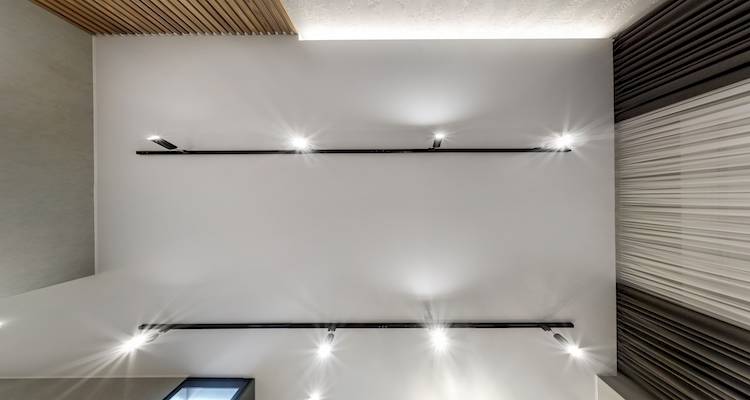
Pros
- ✔ Low-cost option
- ✔ Many different styles are available
- ✔ Durable
- ✔ Lightweight
Cons
- ✖ Not the most attractive option
Checklist: Hiring Contractors for Installing A False/Suspended Ceiling
There are several things you may have to Consider when hiring a contractor to install the suspended ceiling for you. Below is a list of some of the main things that you should Consider when finding the right contractors for the job:
- Do the contractors provide any guarantees with their work, and what is included in this guarantee?
- How much does the work cost to complete? – Ask for a breakdown of costs so you can be sure you are paying a good price for each element of the job.
- Are the contractors experienced in installing the type of suspended ceiling that you require?
- How much experience does the contractor have in installing suspended ceilings?
- Will the contractor fix any issues that may arise?
- Do you need to hire any additional contractors for any parts of the job?
- Do you need to provide anything to the contractors for the work?
- How long will the work take to complete?
- Can the contractors provide any photos of their previous work?
- Will the contractors take care of any relevant waste removal as part of the job?
FAQs
What is a false ceiling?
There is usually a hollow space left between the new false ceiling and the original ceiling. This can be very useful for insulating and soundproofing.
What are suspended ceiling tiles made of?
What are the most common types of suspended ceiling tiles?
What are suspended ceiling tiles?
Can a suspended ceiling be painted?
If you would like a different colour for your ceiling, it may be easier, quicker, and cheaper to simply replace the tiles with new ones rather than painting them.
How do I stop my tiles from lifting in the wind when I open the external door?
You can also choose to clip the tiles in place using some universal hold-down clips. This will help hold the tiles down and prevent them from lifting out of place if wind enters the property.



